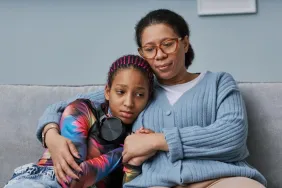Talking to strangers, however, is a topic that all parents confront at some point. Strangers are everywhere, and the truth is that some kids are simply more outgoing than others. Those talkative, super friendly kids do need to learn when to reach out to strangers and when to run the other way.
Each time I fly my kids across the country, I begin the long day of travel with the same pep talk. “The airport is full of people we don’t know in a hurry to catch flights,” I caution. “Stay next to Mommy and hold hands.” We are big on the buddy system in this family, so the hand holding and staying close applies whether we are traveling or just picking up groceries. Safety in numbers does work, as long as you remind kids to pay attention to the numbers (as in, yell if your sister suddenly goes missing in aisle 12).
Talking to kids about strangers is anxiety producing for parents (who wants to consider the possibility of a missing child?) and for kids. At around age 4, kids begin to understand that the world is a big and complex place. It’s hard to find the real friendly face in the crowd when everyone seems to be smiling. That’s actually a tall order for a little kid. When parents ask me how to discuss “stranger danger” with little ones, I actually counsel them to begin by changing the wording to “stranger safety” instead.
The truth is that adults send a lot of mixed messages. We tell children not to talk to strangers, but then we encourage them to say hello to the mail carrier, the barista at Starbucks, the checker at the grocery store, and countless other strangers that we consider safe. On the one hand, we tell them that strangers are dangerous, but, on the other hand, we expect them to interact with strangers as long as we pre-screen them first.
There’s no one perfect way to teach stranger safety (telling your introverted child to scream, for instance, probably won’t work), and stranger safety isn’t a one-time lesson. You need to discuss it early and often and change the language as your children grow. It’s also important to account for personality and temperament. What is a realistic safety plan for your child? Will your child scream and run or would a safety whistle work better?
Many kids scare easily, and hyper-focusing on the danger aspect can cause anxiety for some kids. You want your kids to walk with confidence and speak with an assertive voice, right? If you teach them that the world is a scary place and pedophiles are lurking around every corner, your kids won’t want to leave your side anytime soon.
Try a few of these tips to discuss stranger safety with your kids without scaring them:
1. Teach them to run and yell
The National Crime Prevention Council suggests teaching young children, “No, Go, Yell, Tell.” If kids encounter a dangerous situation they should yell no, run, yell some more, and tell a safe adult. Make sure your kids know that it’s acceptable to say no to an adult and to yell if an adult makes them feel uncomfortable. We spend a lot of time teaching kids to respect adults, but we also need to teach them to say no when something isn’t right.
2. Point out safe strangers
It’s important for kids to know the safe strangers in their neighborhoods. Fire fighters and police officers are the obvious first choice, but I always suggest walking through the neighborhood and talking about the people you know and trust. My kids know where our close friends live, for example, but they also know that the librarian can help should they encounter trouble near the library. Schools, doctors offices, and stores are other places to seek help.
3. Create a family code word
It stands to reason that your child will never be picked up from school or daycare by a stranger, but kids are easily tricked by adults who seem friendly (this is one reason I never put first names on clothing). A family code word gives your kids some control over the situation. If a stranger attempts to convince your child that you sent him, your child can ask for the code word. Just be sure to give friends or relatives the code word if you do need to have someone else fetch your child from school. I use this one with my kids, and they like knowing that we have a secret word that I will only give out in an emergency. It empowers them to take control.
4. Teach them the “one hand on me” rule
One way to help clear up the confusion between safe strangers and dangerous strangers is to implement the “one hand on me” rule. Teach your kids that they can only talk to an adult stranger if they are with a trusted adult. In other words, you screen the strangers for them until they’re old enough to do so on their own.
5. Teach them to be assertive
Some kids are naturally more assertive than others. My son tells it like it is and isn’t afraid to say no, but my daughter has a tendency to be quiet around unfamiliar adults. Both need practice when it comes to asserting their rights and needs.
Assertive communication means using a firm but appropriate voice tone, standing tall, and stating your needs clearly while making eye contact. Teach your kids to do this. Practice often. Be certain that your kids know that their feelings matter and that they can say no to an adult.
6. Teach them to trust their instincts
Kids know when something doesn’t seem right, but they might not act on their instincts for fear of getting in trouble or getting someone else in trouble. Empower your kids to listen to their instincts and run from a situation that doesn’t feel right. It’s better to run and find a trusted adult than to wait and see what might happen.
7. Remind them to stay with the group
Safety in numbers only works if the numbers stay together. Teach your child to stay with their group and never to leave the group without talking to the adult in charge.
Photo: Getty








